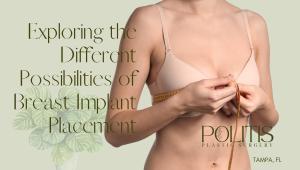Introduction


 Breast augmentation is a popular cosmetic procedure used to enhance the size, shape, and symmetry of the breasts. When considering this surgery, the type and placement of breast implants is an important decision. There are three main placement options: submuscular, subglandular, and subfascial. Each one carries certain advantages and disadvantages, and it is important to understand these in order to make an informed decision.
Breast augmentation is a popular cosmetic procedure used to enhance the size, shape, and symmetry of the breasts. When considering this surgery, the type and placement of breast implants is an important decision. There are three main placement options: submuscular, subglandular, and subfascial. Each one carries certain advantages and disadvantages, and it is important to understand these in order to make an informed decision.
Submuscular Implants (Under the Chest Muscle)
Submuscular implants are placed beneath the pectoralis major muscle, which covers the chest wall. This is the most common placement for breast augmentation, as it provides natural-looking breast contours and motion.
How It Is Performed
The surgeon will make a small incision either on the chest, under the breast, or in the armpit, then insert the implants and position them below the pectoralis muscle. This placement provides extra support and can help reduce the risk of capsular contracture, a complication caused by scar tissue forming around the implants.
Benefits of This Technique
The main benefit of this technique is its natural appearance, as the implants are hidden beneath the muscle. This can also create a more defined cleavage, as the muscle helps to push the implants together. In addition, submuscular placement helps to minimize the risk of complications, such as capsular contracture, implant rippling, and implant visibility.
Possible Risks
The main risk associated with this technique is a longer recovery period. As the muscle is moved to insert the implants, it can cause more post-operative soreness and swelling. This placement also requires more dissection, which can lead to increased pain and bleeding in some cases.
Subglandular Implants (Above the Chest Muscle)
Subglandular implants are placed directly on top of the chest wall. This placement is less common than submuscular, as it provides less support and can create a less natural look.
How It Is Performed
The implants are inserted through an incision either in the armpit, under the breast, or around the areola, then placed directly on top of the chest wall. This technique is relatively straightforward and can be performed with minimal dissection.
Benefits of This Technique
One of the biggest advantages of this technique is that it does not require moving the chest muscle, which can lead to less pain and a quicker recovery. It also requires less surgical dissection, which can reduce the risk of complications.
Possible Risks
The main disadvantage of this technique is that it can create a less natural look, as the implants are not hidden under the muscle. In addition, it can result in implant visibility, rippling, and higher risk of capsular contracture.
Subfascial Implants (Between Muscles and Fibrous Tissue of the Chest)
Subfascial implants are placed between the pectoral muscle and the fibrous layer underneath it. This is a newer technique with several advantages, such as less bleeding and a more natural look.
How It Is Performed
The implants are placed behind the pectoral major muscle and between the muscle and the fibrous layer below it. This placement allows the surgeon to avoid moving the muscle, which can reduce the risk of complications.
Benefits of This Technique
The main benefit of this technique is its natural look, as the implants are less visible when placed between the layers of chest tissue. It also provides more support and reduces the risk of complications, such as capsular contracture, implant rippling, and implant visibility.
Possible Risks
The main potential risks associated with this technique include pain from the increased pressure on the surrounding tissue and infection due to the extra dissection.
Conclusion
When considering breast augmentation, it is important to understand the different types and placements of implants. Submuscular implant placement is the most common choice, as it provides the most natural appearance and increases the support for the implants. Subglandular placement is less common but can provide a quicker recovery with fewer potential complications. Subfascial placement is a newer technique that provides a more natural look and reduces the risk of complications. Ultimately, it is important to weigh the advantages and disadvantages of each placement option and discuss them with a board-certified plastic surgeon.
Politis Plastic Surgery
Dr. Effie Politis is a board-certified plastic surgeon in Tampa, FL with decades of experience in plastic and reconstructive surgery. At her clinic, Politis Plastic Surgery, she offers a wide range of procedures, including breast augmentation. With state-of-the-art facilities and the latest techniques and technologies, she is dedicated to helping her patients achieve their desired results. To learn more or to schedule a consultation, call Politis Plastic Surgery today.
References: